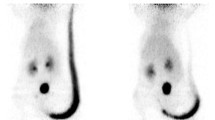Abstract
Purpose
We compared alternative routes for 18F-fluorodeoxyglucose (FDG) administration, such as the retroorbital (RO), intraperitoneal (IP) and per oral (PO) routes, with the intravenous (IV) route in normal tissues and tumors of mice.
Materials and Methods
CRL-1642 (ATCC, Lewis lung carcinoma) cells were inoculated in female BALB/c-nu/nu mice 6 to 10 weeks old. When the tumor grew to about 9 mm in diameter, positron emission tomography (PET) scans were performed after FDG administration via the RO, IP, PO or IV route. Additional serial PET scans were performed using the RO, IV or IP route alternatively from 5 to 29 days after the tumor cell injection.
Results
There was no significant difference in the FDG uptake in normal tissues at 60 min after FDG administration via RO, IP and IV routes. PO administration, however, showed delayed distribution and unwanted high gastrointestinal uptake. Tumoral uptake of FDG showed a similar temporal pattern and increased until 60 min after FDG administration in the RO, IP and IV injection groups. In the PO administration group, tumoral uptake was delayed and reduced. There was no statistical difference among the RO, IP and IV administration groups for additional serial PET scans.
Conclusion
RO administration is an effective alternative route to IV administration for mouse FDG PET scans using normal mice and tumor models. In addition, IP administration can be a practical alternative in the late phase, although the initial uptake is lower than those in the IV and RO groups.



Similar content being viewed by others
References
Endepols H, Sommer S, Backes H, Wiedermann D, Grat R, Hauber W. Effort-based decision making in the rat: an [18 F] fluorodeoxyglucose micro positron emission tomography study. J Neurosci. 2010;30:9708–14.
Liang Z, Cho HT, Williams L, Zhu A, Liang K, Huang K, et al. Potential biomarker of L-type amino acid transporter 1 in breast cancer progression. Nucl Med Mol Imaging. 2011;45:93–102.
Lancelot S, Zimmer L. Small-animal positron emission tomography as a tool for neuropharmacology. Trends Pharmacol Sci. 2010;31:411–7.
Frangioni JV, Hajjar RJ. In vivo tracking of stem cells for clinical trials in cardiovascular disease. Circulation. 2004;110:3378–83.
Wyss MT, Honer M, Schubiger PA, Ametamey SM. NanoPET imaging of [18F] fluoromisonidazole uptake in experimental mouse tumours. Eur J Nucl Med Mol Imaging. 2006;33:311–8.
Jacobson MS, Dankwart HR, Mahoney DW. Radiolysis of 2-[18F]fluoro-2-deoxy-D-glucose ([18F]FDG) and the role of ethanol and radioactive concentration. Appl Radiat Isot. 2009;67:990–9957.
Higashi T, Fisher SJ, Nakada K, Romain DJ, Whal RL. Is enteral administration of fluorine-18-fluorodeoxyglucose (F-18 FDG) a palatable alternative to IV injection? Pre-clinical evaluation in normal rodents. Nucl Med Biol. 2002;29:363–73.
Fueger BJ, Czernin J, Hildebrandt I. Impact of animal handling on the results of 18 F-FDG PET studies in mice. J Nucl Med. 2006;47:999–1006.
Nanni C, Pettinato C, Ambrosini V, Spinelli A, Trespidi S, Rubello D, et al. Retro-orbital injection is an effective route for radiopharmaceutical administration in mice during small-animal PET studies. Nucl Med Commun. 2007;28:547–53.
Steel CD, Stephen AL, Hahto SM, Singletery SJ, Ciavarra RP. Comparison of the lateral tail vein and the retro-orbital venous sinus as routes of intravenous drug delivery in a transgenic mouse model. Lab Anim. 2008;37:26–32.
Schoell AR, Heyde BR, Weir DE, Chiang PC, Hu Y, Tung DK. Euthanasia method for mice in rapid time-course pulmonary pharmacokinetic studies. J Am Assoc Lab Anim Sci. 2009;48:506–11.
Schiffer WK, Mirrione MM, Deway SL. Optimizing experimental protocols for quantitative behavioral imaging with 18F-FDG in rodent. J Nucl Med. 2007;48:277–87.
Atkinson RM, Parsons BJ, Smyth DH. The intestinal absorption of glucose. J Physiol. 1957;135:581–9.
Acknowledgements
This research was supported by the Pioneer Research Center Program through the National Research Foundation of Korea funded by the Ministry of Education, Science and Technology (2010-0002209).
Author information
Authors and Affiliations
Corresponding author
Rights and permissions
About this article
Cite this article
Kim, C., Kim, I.H., Kim, Si. et al. Comparison of the Intraperitoneal, Retroorbital and per Oral Routes for F-18 FDG Administration as Effective Alternatives to Intravenous Administration in Mouse Tumor Models Using Small Animal PET/CT Studies. Nucl Med Mol Imaging 45, 169–176 (2011). https://doi.org/10.1007/s13139-011-0087-7
Received:
Accepted:
Published:
Issue Date:
DOI: https://doi.org/10.1007/s13139-011-0087-7




